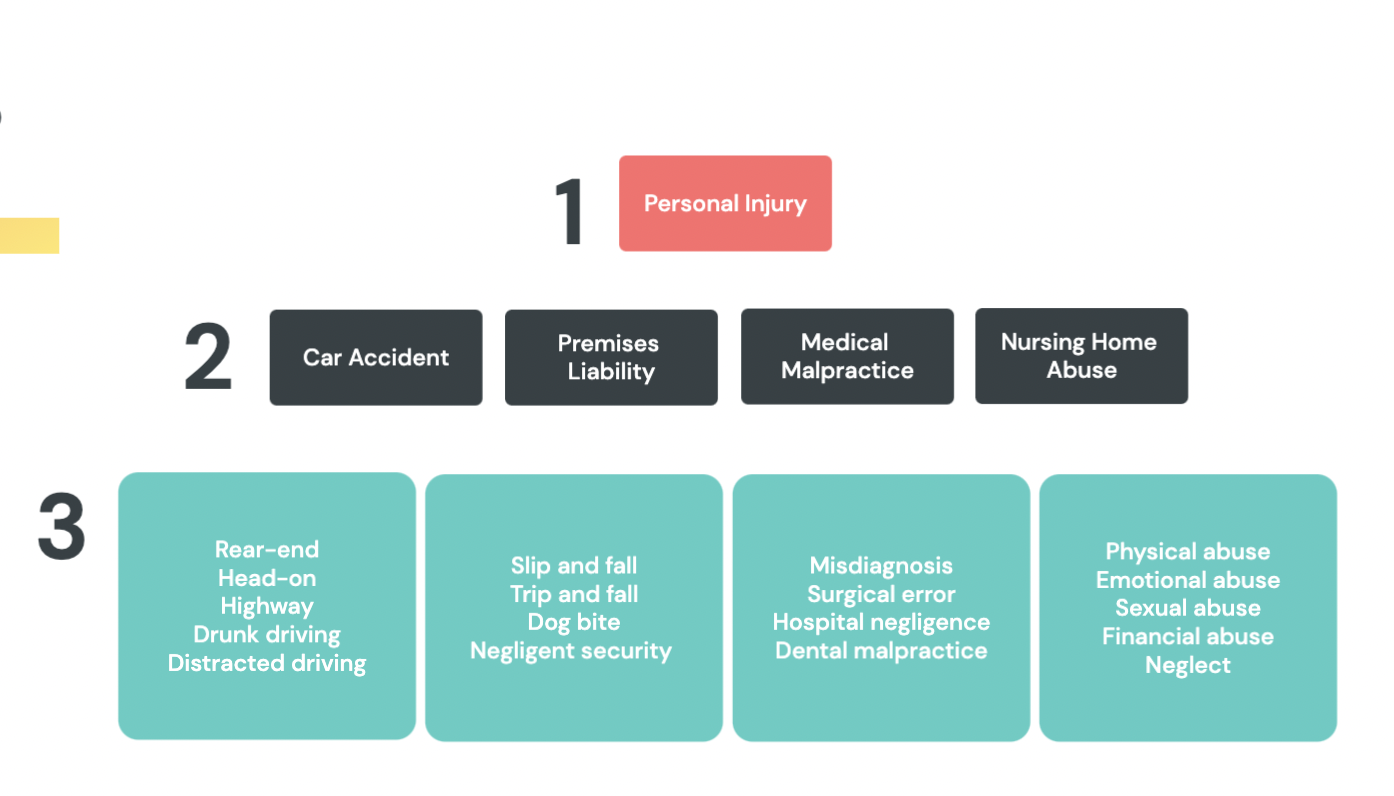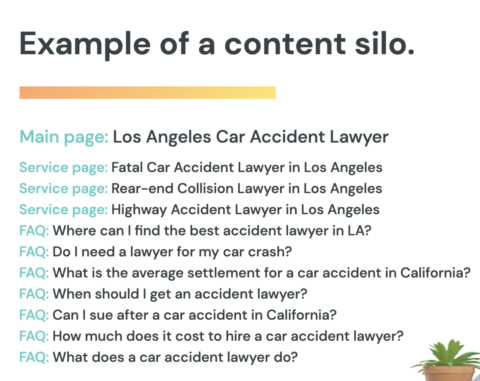Many law firms are simply leasing space when it comes to their online marketing.
Whether it’s Google pay-per-click (PPC) ads, Facebook Ads, or social media, these channels often yield only temporary wins. Once you pull the investment, your results go away entirely.
Your website, on the other hand, can be a 24/7 selling tool for your law firm practice. It can effectively become your greatest asset, getting leads and cases while you sleep.
In this guide, we’ll talk about how to turn your website into the ultimate marketing tool for your law firm practice and generate seven figures in revenue for your business.
A Well-Optimized Law Firm Website Can Yield Huge Results
With your law firm’s website, you can use content marketing to your advantage to generate lucrative results for your business. Content and SEO allow you to attract users organically and convert traffic passively into new cases for your law firm.
As an example, a high-ranking webpage in a competitive market getting 1,000 users per month can get huge results:
- Convert visitors at 2-5% = 20-50 leads.
- Convert even 10-20% of leads = 2-10 cases.
- Average $8000 revenue per case = $16,000-$80,000 monthly revenue from one page.
Over the course of a year, this could lead to high six-figures to seven-figures in revenue!
The Foundations Of A Revenue-Generating Law Firm Website
At its core, your law firm website should serve to speak to the needs, struggles, and interests of your target audience. It should be laser-focused on your practice area, who you serve, and what you have to offer.
With this in mind, a well-crafted website content strategy should define:
- Your business goals (the cases you want).
- What competitors are doing.
- What pages to write and keywords to target.
- How to use your content budget.
- Your editorial calendar.
- The purpose/intent of each page.
- PR and backlink strategy.
Below, we’ll dive deeper into how to develop this strategy, build out amazing content, and achieve your seven-figure revenue goals.
1. Define The Cases You Want
The first step to developing a successful website marketing strategy is to define the types of legal cases you want.
This activity will help you determine the types of people you want to reach, the type of content you should create, and the types of SEO keywords you need to target.
That way, you end up marketing to a more specific subset of potential clients, rather than a broad range of users.
Not sure where to set your focus? Here are a few questions that might help:
- Which of your cases are the most profitable?
- What types of cases are you not getting enough of?
- In what markets are you strongest?
- In which markets do you want to improve?
- Are there any practice areas you want to explore?
At the end of this activity, you might decide that you want to attract more family law cases, foreclosure law cases, or DUI cases – whatever it is, getting hyper-focused on the types of cases you want to attract will only make your website marketing even stronger.
2. Identify Your Top Competitors
One of the best ways to “hack” your website marketing strategy is to figure out what’s working for your competitors.
By “competitors” we mean law firms that are working to attract the types of cases you’re trying to attract, at the same level at which your law firm is currently operating.
I say this because I see many law firms trying to out beat and outrank the “big” fish and this can feel like a losing battle. You want to set your sights on your closest competitors, rise above them, and then get more competitive with your strategy.
Here are a few ways to identify your closest competitors:
- Conduct a Google search of your legal practice area + your service area (e.g., “family law Kirkland”, “DUI lawyer LA”, “Denver probate attorney” etc.). Take note of the top-ranking domains (i.e., websites).
- Use SEO tools like Semrush or Ahrefs to search your domain name. These tools will often surface close competitors to your domain.
- Using the same tools above, conduct organic research on your domain to see what keywords you are already ranking for. Search these keywords in Google and see what other domains come up.
- Use these tools to determine the domain authority (DA) of your domain. Compare this to the other top-ranking domains to see which domains have an authority score that’s similar to your own.
Be sure to look at your known business competitors as well.
These may or may not be ranking well in Google Search, but it’s still worth a peek to see if they are targeting any high-priority keywords that your website should be targeting.
3. Conduct A Content Audit Of Your Website
Your next step is to conduct an audit of your current website. This will allow you to take stock of what content is performing well, and what content requires improvement.
First, start with your main service pages.
Use SEO tools like Semrush or Ahrefs again to review the rank (position), performance, and keywords of each page. Identify any pages that are ranking low, or not at all.
Then, find “low-hanging fruit” pages. These are the pages that are ranking around position 5-10. They require less effort to optimize to reach those higher rank positions – compared to pages ranking at, say, position 59.
Next, use the same tools to conduct a “gap analysis” (most SEO tools have this feature).
This compares your website’s performance to that of your closest competitors. It will show you a list of keywords that your competitors are ranking for that your website is not ranking for at all.
Finally, create an inventory of what pages you already have, which need to be revised, and which you need to create. Doing so will help you stay organized and stay on task when developing your content strategy.
4. Plan Your Content Silos
By this step, you will have a pretty good idea of what pages you already have, and which pages are “missing” from your strategy (based on the list of keywords you are not yet targeting).
From here, you will plan what’s called “content silos”.
Here is the basic process:
- Review an existing service page (if you have one) and optimize it as best you can. Ideally, this is a page that’s already performing well and is otherwise a “low-hanging fruit” page.
- If you don’t have any existing service pages, create one based on one of your high-priority keywords. Again, these should be a keyword that is meant to attract your preferred type of cases.
- Next, build a “silo” of content around your main page. In other words, create new pages that are topically related to your main service page, but that target slightly different keywords (ideally, “long-tail”, lower competition keywords).
- Add internal links between these pages and your primary service page.
- Over time, build backlinks to these pages (through guest posting, PR, content marketing, etc.)
Below is an example of a content silo approach for “personal injury:”
 Image from author, November 2022
Image from author, November 20225. Identify Supporting Topics
As part of your website content strategy, you’ll then want to create other supporting content pieces. This should be content that provides value to your potential clients.
FAQs, blogs, and other service pages can support your main pages.
For example, if you are a DUI lawyer, you might want to publish an FAQ page that addresses the main questions clients have about DUI law, or a blog post titled “What to Do When You Get a DUI.”
There are a few tools you can use to research supporting topics:
- Semrush – Use this tool to identify untapped keywords, content topics, and more.
- AlsoAsked – Identify other questions people have searched for relevant to your primary topic.
- Answer the Public – Use this search listening tool to identify topics and questions related to your practice area.
Below is an example of how the full content silo can come together for “Los Angeles Car Accident Lawyer:”
 Image from author, November 2022
Image from author, November 20226. Build An Editorial Calendar
Once you have all of your content ideas down on paper, it’s time to develop your editorial calendar.
This is essentially a plan of what content you need to create when you want to publish it, and what keywords you plan to target.
This can be as simple as a Google Sheet or as fancy as a project management tool (like Monday.com or Asana).
Here are a few tips to get you started:
- Always prioritize main pages. These should be the first content pieces you create on your website.
- Create or revise your main pages and monitor their performance. Use Google Analytics and other SEO tools to keep your eye on how your content is performing.
- Depending on budget and urgency, you might start with all main pages, or go silo by silo. Determine which service pages are most important to you. You can create all of your main pages at once, or develop the entire silo as you go.
- Keep a record of your target keywords. Just because you “optimize” for them doesn’t mean your content will automatically rank for your target keywords. In your editorial calendar, keep track of the keywords you wish to target – by page – so you have a record of your original SEO strategy.
What Makes A Winning Law Firm Website Strategy?
The key to achieving seven figures with your law firm website is content.
Content allows you to target your ideal clients, attract your preferred cases, engage your audience, and so much more.
A well-thought-out content strategy will empower your website to achieve more for your business than any other marketing channel could!
Above, I outline a few steps to developing this type of winning strategy. But, achieving excellence takes time.
I recommend keeping your eye on the prize, monitoring performance, and making updates as you go along.
This will help you reach your desired result.
More resources:
Featured Image: PanuShot/Shutterstock
 seolounge
seolounge